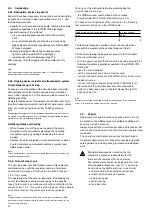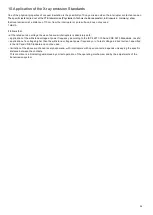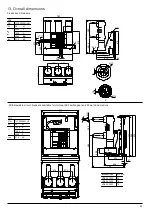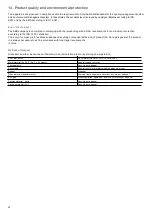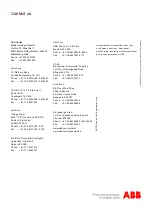
7. Installation
7.1.
General
Correct installation is of primary importance. The
manufacturer’s instructions must be carefully stud -
ied and followed. It is good practice to use gloves
for handling the pieces during installation.
7.2.
Installation and operating conditions
The following Standards must be taken into particular
consideration during installation and service:
– IEC 62271-1/DIN VDE 0101
– VDE 0105: Electrical installation service
– DIN VDE 0141: Earthing systems for installations with rated
voltage above 1 kV
– All the accident prevention regulations in force in the relative
countries.
7.2.1. Normal conditions
Follow the recommendations in the IEC 62271-1 and 62271-
100 Standards. In more detail:
Ambient temperature
Maximum
+ 40 °C
Average maximum over 24 hours
+ 35 °C
Minimum (according to class– 5),
apparatus for indoor installation
– 5°
Humidity
The average value of the relative humidity, measured for a period longer
than 24 hours, must not exceed the 95%.
The average value of the pressure of the water vapour, measured for a
period longer than 24 hours, must not exceed 2.2 kPa.
The average value of the relative humidity, measured for a period longer
than 1 month, must not exceed the 90%.
The average value of the pressure of the water vapour, measured for a
period longer than 1 month, must not exceed 1.8 kPa.
Altitude
< 1000 m above sea level.
7.2.2. Special conditions
Installations over 1000 m a.s.l.
Possible within the limits permitted by reduction of the dielectric resistance
of the air.
Increase in the ambient temperature
Reduction in the rated current.
Encourage heat dissipation with appropriate additional ventilation.
Climate
To avoid the risk of corrosion or other damage in areas:
– with a high level of humidity, and/or
– with rapid and big temperature variations, take appropriate steps (for
example, by using suitable electric heaters) to prevent condensation
phenomena.
For special installation requirements or other operating
conditions, please contact ABB.
The areas involved by the passage of power
conductors or auxiliary circuit conductors must
be protected against access of any animals which
might cause damage or disservices.
7.2.3. Trip curves
The following graphs show the number of closing-opening
cycles (No.) allowed, of the vacuum interrupters, according to
the breaking capacity (Ia).
Caption (Figs. 8...)
No. Number of closing-opening cycles allowed for the vacuum
interrupters.
Ia: Breaking capacity of the vacuum interrupters.
16
























